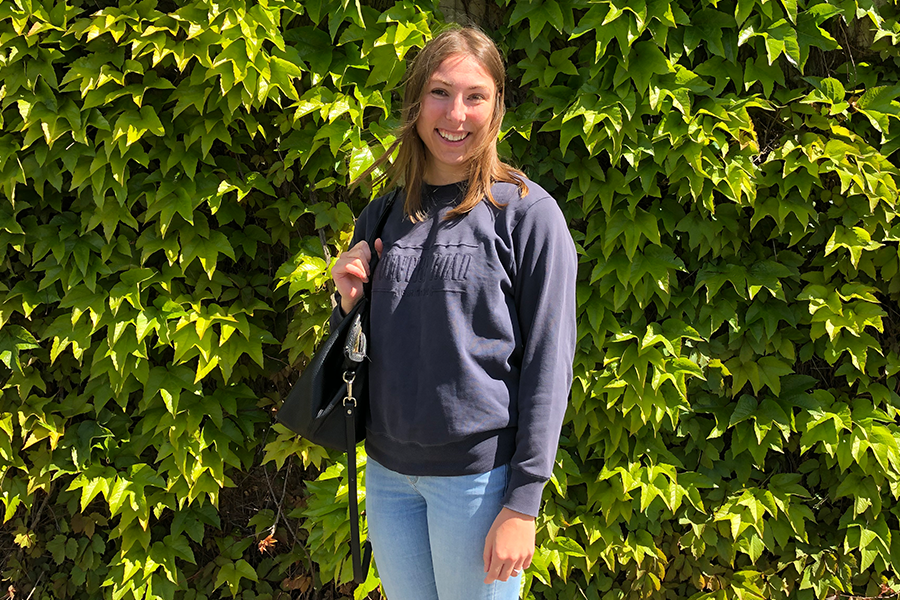
PhD candidate Hannah Martin has been looking into intuitive eating which she says is an 'anti-diet' approach to eating.
Why do we eat the way we do?
That’s just part of what PhD candidate Hannah Martin, of the Department of Human Nutrition, is hoping to find out as part of her research examining the relationship between different qualities of motivation and intuitive eating.
Martin says intuitive eating is taking an “anti-diet” approach to eating.
The practise was developed by two dietitians, who wrote the first book on intuitive eating, in 1995. At the time, the pair were designing diet plans for their clients, who would frequently return saying they couldn’t stick to their plan.
“It was developed from their experiences as dietitians.”
When Martin worked as a community dietitian herself, she noticed many of her clients were mid-aged women who had been dieting their entire life.
“They started their diets in their late teens and had just been continuing that diet roller coaster all through their life essentially.
“That’s why intuitive eating can be quite helpful for mid-age women.”
For Martin’s research she defines mid-life as between 40 and 50 years.
Her research has focused on four key aspects of the practise, the first being reliance on hunger and satiety cues, which sees people tuning into their physiological cues.
The second aspect is unconditional permission to eat.
“So that’s really taking an all-foods-fit approach, unlike diets which are very much like ‘you shouldn’t eat this, this is good; this is bad’. It’s kind of removing those restrictions.”
Aspect three is body food choice congruence. Someone who practises intuitive eating will primarily choose foods that help their body to function well.
“That could look like choosing foods that are high in fibre or eating a wide variety of foods to ensure you’re getting a range of nutrients”
The fourth and final aspect of intuitive eating Martin’s research has focused on is eating for physical rather than emotional reasons.
“So, choosing food to fuel the body, and finding other ways to cope with emotions such as boredom, loneliness or stress, things like that.”
Mid-life is a possible "window of vulnerability" for the development of disordered eating and negative body image for women, similar to the teenage years.
The anti-diet approach of intuitive eating aims to shift people’s focus from weight and weight loss to focusing more on their health, Martin says.
“Rather than trying to get the scale numbers down, it’s focusing more on the internal experience of the body: How am I actually feeling when I eat this food, how is it helping me function and perform, help me do what I want to do in life?.”
Martin’s research is bringing in self-determination theory to explain why some people might be more intuitive eaters than others.
Self-determination theory distinguishes between different qualities and amounts of motivation - rather than just high or low levels of motivations, she says.
Controlled motivation is a type of motivation where someone feels pressure to engage in a behaviour, there is a feeling of obligation. Autonomous motivation, on the other hand, is a type of motivation where someone engages in a behaviour for more personal reasons, such as because its valued or enjoyable.
“You’re doing it for your own personal reasons rather than because someone’s told you to.”
The theory suggests that much like people have physical needs for things like food and water, they also have basic psychological needs, and that supporting those helps facilitate more autonomous motivations.
A person may start off doing a behaviour for external reasons, but after seeing benefits for themselves, the motivation then comes from within, Martin says.
Most people are born an intuitive eater.
“Babies are intuitive eaters; they cry when they’re hungry and they turn away from food when they’re full.”
Overtime, however, messages children receive from friends, family, society, and the media can change this.
“These messages could look like: ‘you’ve just got one more mouthful of this left, finish it off’, or ‘you’ve got to finish everything on your plate’.”
It’s then that young children start listening to the external messages and ignoring their own cues.
- Korero by internal communications adviser, Koren Allpress